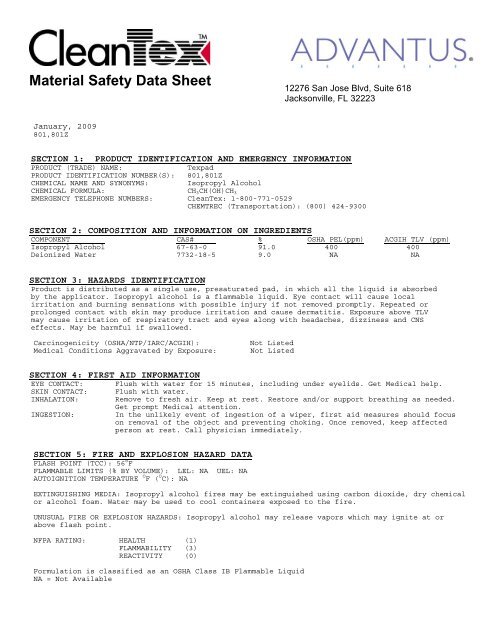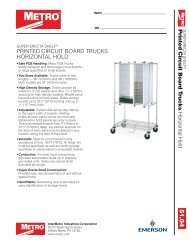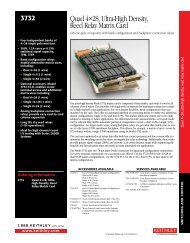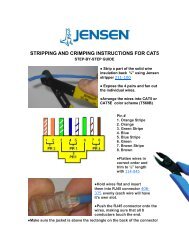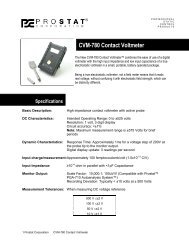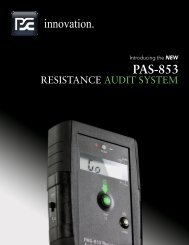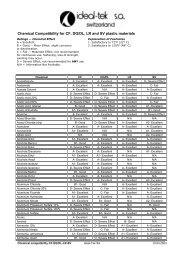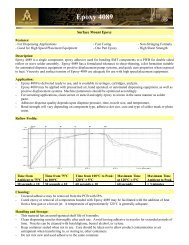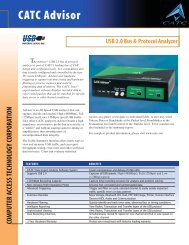CleanTex Material Safety Data Sheet - Stanley Supply & Services
CleanTex Material Safety Data Sheet - Stanley Supply & Services
CleanTex Material Safety Data Sheet - Stanley Supply & Services
You also want an ePaper? Increase the reach of your titles
YUMPU automatically turns print PDFs into web optimized ePapers that Google loves.
<strong>Material</strong> <strong>Safety</strong> <strong>Data</strong> <strong>Sheet</strong><br />
12276 San Jose Blvd, Suite 618<br />
Jacksonville, FL 32223<br />
January, 2009<br />
801,801Z<br />
SECTION 1: PRODUCT IDENTIFICATION AND EMERGENCY INFORMATION<br />
PRODUCT (TRADE) NAME:<br />
Texpad<br />
PRODUCT IDENTIFICATION NUMBER(S): 801,801Z<br />
CHEMICAL NAME AND SYNONYMS:<br />
Isopropyl Alcohol<br />
CHEMICAL FORMULA:<br />
CH3CH(OH)CH<br />
3<br />
EMERGENCY TELEPHONE NUMBERS: <strong>CleanTex</strong>: 1-800-771-0529<br />
CHEMTREC (Transportation): (800) 424-9300<br />
SECTION 2: COMPOSITION AND INFORMATION ON INGREDIENTS<br />
COMPONENT CAS# % OSHA PEL(ppm) ACGIH TLV (ppm)<br />
Isopropyl Alcohol 67-63-0 91.0 400 400<br />
Deionized Water 7732-18-5 9.0 NA NA<br />
SECTION 3: HAZARDS IDENTIFICATION<br />
Product is distributed as a single use, presaturated pad, in which all the liquid is absorbed<br />
by the applicator. Isopropyl alcohol is a flammable liquid. Eye contact will cause local<br />
irritation and burning sensations with possible injury if not removed promptly. Repeated or<br />
prolonged contact with skin may produce irritation and cause dermatitis. Exposure above TLV<br />
may cause irritation of respiratory tract and eyes along with headaches, dizziness and CNS<br />
effects. May be harmful if swallowed.<br />
Carcinogenicity (OSHA/NTP/IARC/ACGIH):<br />
Medical Conditions Aggravated by Exposure:<br />
Not Listed<br />
Not Listed<br />
SECTION 4: FIRST AID INFORMATION<br />
EYE CONTACT: Flush with water for 15 minutes, including under eyelids. Get Medical help.<br />
SKIN CONTACT: Flush with water.<br />
INHALATION: Remove to fresh air. Keep at rest. Restore and/or support breathing as needed.<br />
Get prompt Medical attention.<br />
INGESTION:<br />
In the unlikely event of ingestion of a wiper, first aid measures should focus<br />
on removal of the object and preventing choking. Once removed, keep affected<br />
person at rest. Call physician immediately.<br />
SECTION 5: FIRE AND EXPLOSION HAZARD DATA<br />
FLASH POINT (TCC): 56 o F<br />
FLAMMABLE LIMITS (% BY VOLUME): LEL: NA UEL: NA<br />
AUTOIGNITION TEMPERATURE O F ( O C): NA<br />
EXTINGUISHING MEDIA: Isopropyl alcohol fires may be extinguished using carbon dioxide, dry chemical<br />
or alcohol foam. Water may be used to cool containers exposed to the fire.<br />
UNUSUAL FIRE OR EXPLOSION HAZARDS: Isopropyl alcohol may release vapors which may ignite at or<br />
above flash point.<br />
NFPA RATING: HEALTH (1)<br />
FLAMMABILITY (3)<br />
REACTIVITY (0)<br />
Formulation is classified as an OSHA Class IB Flammable Liquid<br />
NA = Not Available
January, 2009<br />
801,801Z<br />
Page 2<br />
SECTION 6: ACCIDENTAL RELEASE MEASURES<br />
Since the isopropyl alcohol solution is completely absorbed by the applicator and the amount of<br />
isopropyl alcohol per applicator is small, the chance of a significant spill occurring is small. In<br />
the event however, a significant amount of liquid is released, ventilate the area, especially low<br />
areas where vapors may collect and remove all sources of ignition. Cleanup personnel need<br />
protection against liquid contact and vapor inhalation.<br />
SECTION 7: HANDLING AND STORAGE<br />
Store in a clean, cool, ventilated area away from sources of ignition and oxidizing agents. Handle<br />
and store in a manner suitable for an OSHA Class IB Flammable Liquid. Electrical services must meet<br />
applicable codes. Use non-sparking tools.<br />
SECTION 8: EXPOSURE CONTROL - PERSONAL PROTECTION<br />
Provide ventilation to maintain TLV. Use non-sparking tools. Avoid inhalation of vapors, contact<br />
with eyes and repeated or prolonged contact with skin. Do not take internally.<br />
SECTION 9: PHYSICAL AND CHEMICAL PROPERTIES<br />
BOILING POINT ( O F( o C)): 180(80) % VOLATILE BY VOLUME @ 25 o C: 100<br />
VAPOR PRESSURE (mmHg @ 25 o C): 33 EVAPORATION RATE(BUTYL ACETATE=1): >1<br />
VAPOR DENSITY (AIR=1):
January, 2009<br />
801,801Z<br />
Page 3<br />
SECTION 14: TRANSPORT INFORMATION<br />
DOT CLASSIFICATION: Not Regulated<br />
Proper Shipping Name:<br />
Hazard Class:<br />
UN Number:<br />
Packing Group:<br />
Hazard Labeling:<br />
IATA/ICAO CLASSIFICATION: Not Regulated<br />
Proper Shipping Name:<br />
Hazard Class:<br />
UN Number:<br />
Packing Group:<br />
Hazard Labeling:<br />
IMDG CLASSIFICATION: Not Regulated<br />
Proper Shipping Name:<br />
Hazard Class:<br />
IMDG Page#:<br />
Packing Group:<br />
Flash Point ( o C):<br />
Marine Pollutant:<br />
SECTION 15: REGULATORY INFORMATION<br />
SARA TITLE III REPORTING:<br />
Toxic Chemical(Section 313):<br />
Not listed<br />
Extremely Hazardous Substance<br />
Not Listed<br />
(Section 302, 304, 311,312):<br />
Hazard Class: Chronic Health Yes<br />
Acute Health<br />
Yes<br />
Fire Hazard<br />
Yes<br />
TSCA INVENTORY STATUS:<br />
Pressure Hazard<br />
Reactivity Hazard<br />
No<br />
No<br />
All components are<br />
listed in the TSCA<br />
inventory<br />
SECTION 16: OTHER INFORMATION<br />
The information provided herein is compiled from internal reports and data from professional<br />
publication. It is furnished without warranty of any kind, expressed or implied. It is intended<br />
solely to assist in evaluating suitability and proper use of the material and in implementing<br />
safety precautions and procedures. Employers should use this information as a supplement to other<br />
information gathered by them and must make independent determination of suitability and<br />
completeness of information from all sources to assure proper use of these materials. All<br />
information used must be determined by the user to be in accordance with applicable federal, state<br />
and local laws and regulations.


